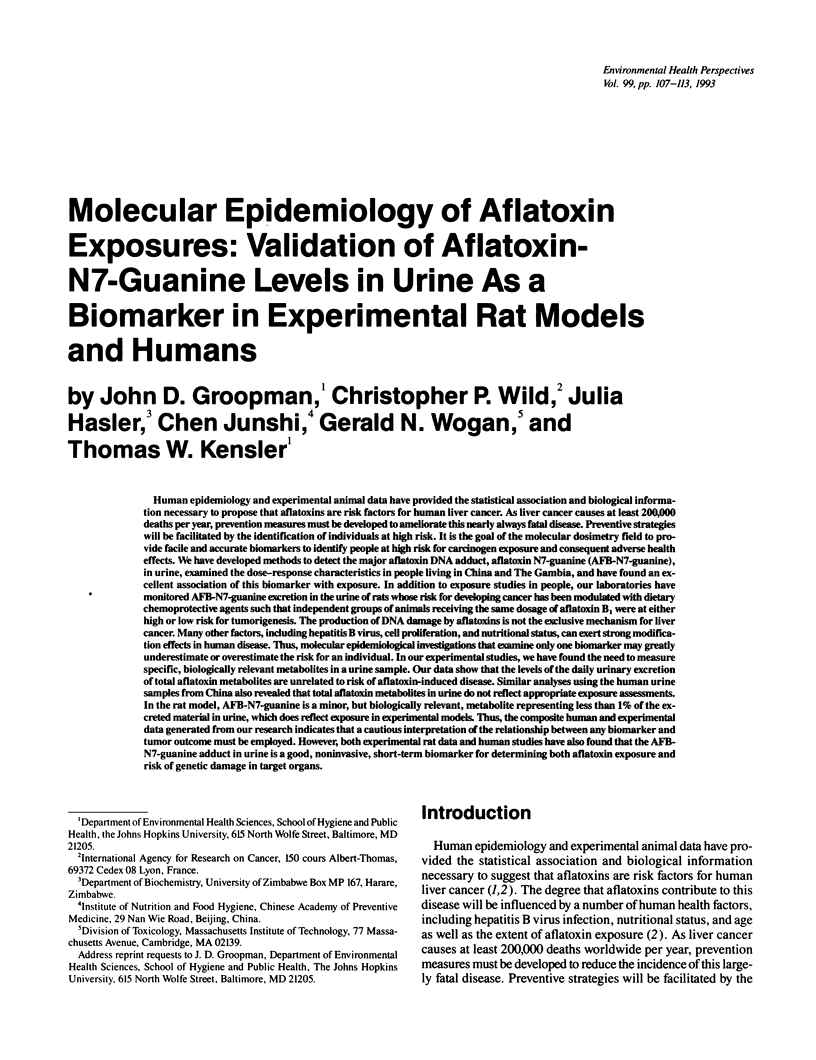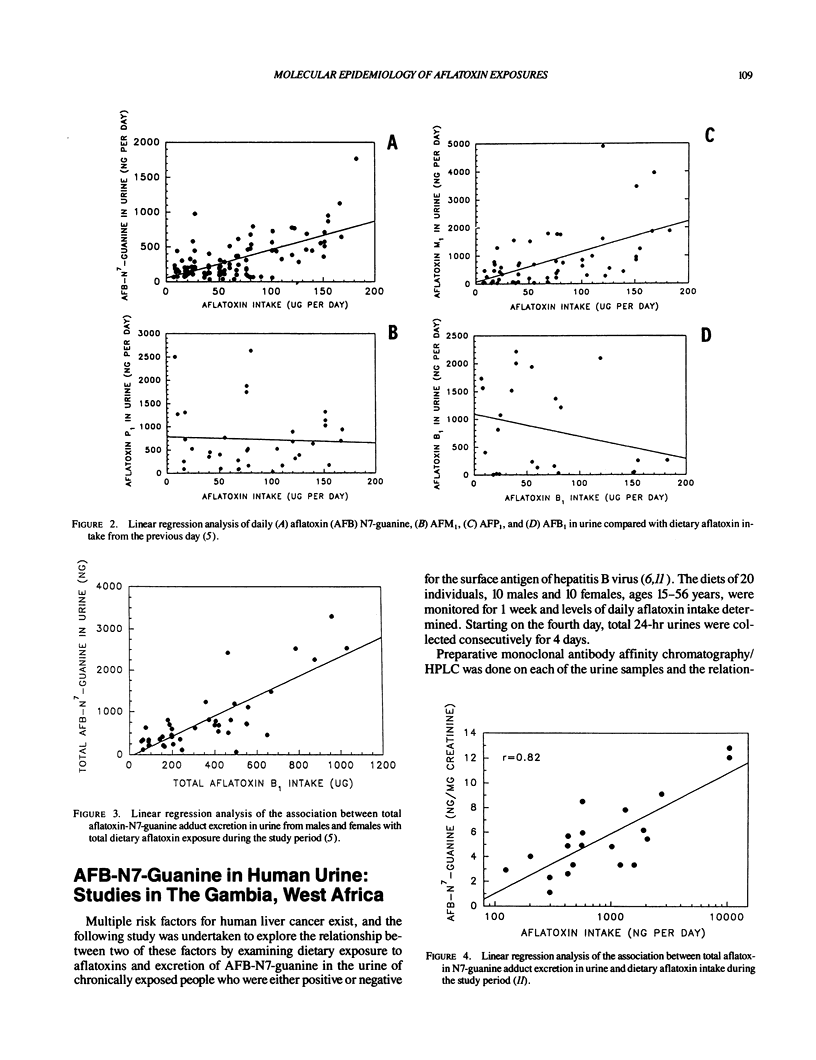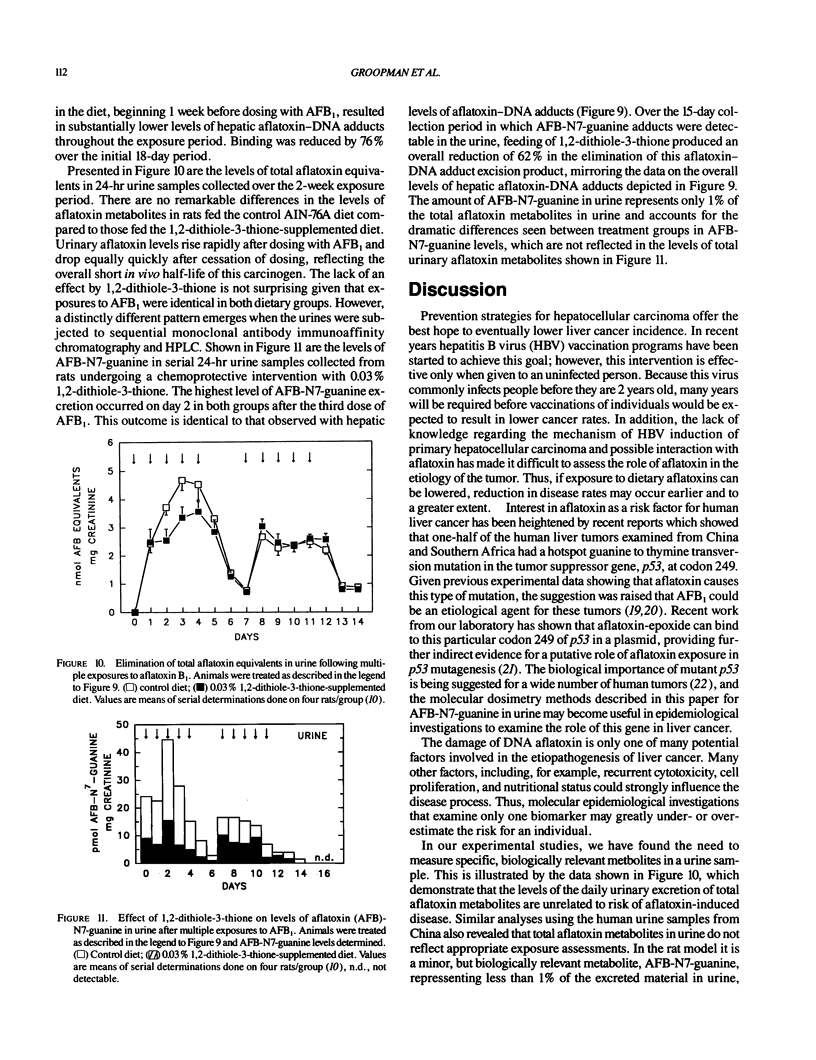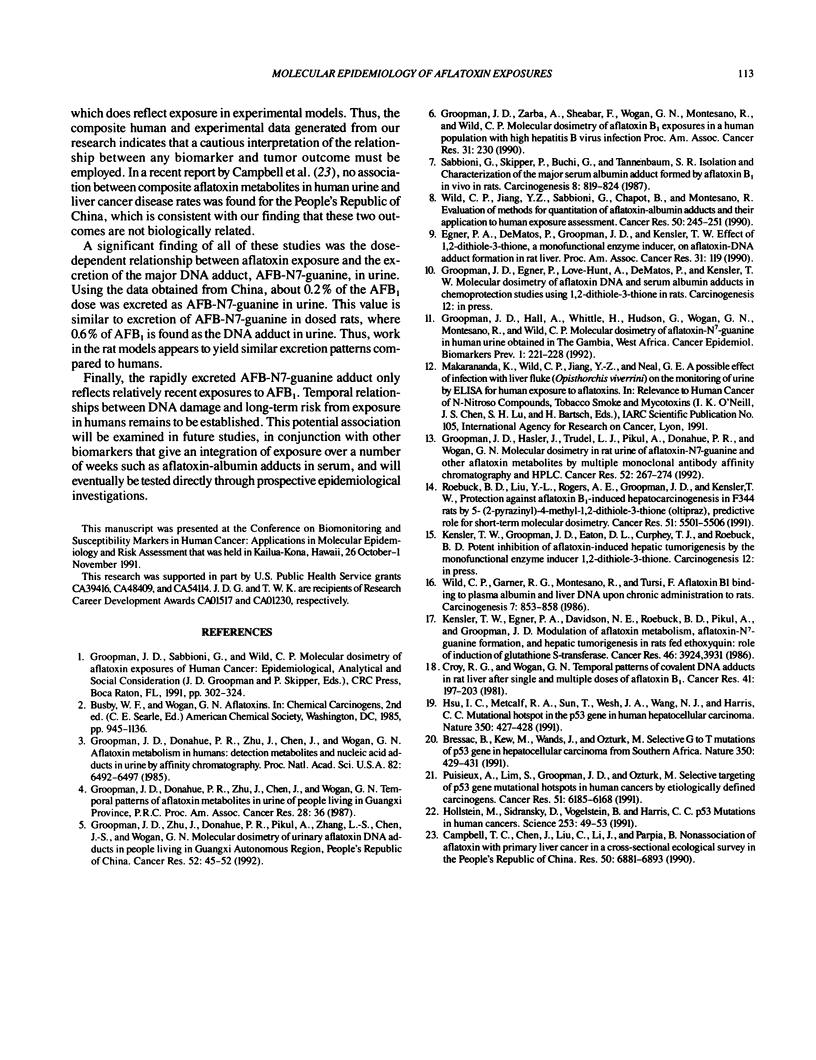Abstract
Human epidemiology and experimental animal data have provided the statistical association and biological information necessary to propose that aflatoxins are risk factors for human liver cancer. As liver cancer causes at least 200,000 deaths per year, prevention measures must be developed to ameliorate this nearly always fatal disease. Preventive strategies will be facilitated by the identification of individuals at high risk. It is the goal of the molecular dosimetry field to provide facile and accurate biomarkers to identify people at high risk for carcinogen exposure and consequent adverse health effects. We have developed methods to defect the major aflatoxin DNA adduct, aflatoxin N7-guanine (AFB-N7-guanine), in urine, examined the dose-response characteristics in people living in China and The Gambia, and have found an excellent association of this biomarker with exposure. In addition to exposure studies in people, our laboratories have monitored AFB-N7-guanine excretion in the urine of rats whose risk for developing cancer has been modulated with dietary chemoprotective agents such that independent groups of animals receiving the same dosage of aflatoxin B1 were at either high or low risk for tumorigenesis. The production of DNA damage by aflatoxins is not the exclusive mechanism for liver cancer. Many other factors, including hepatitis B virus, cell proliferation, and nutritional status, can exert strong modification effects in human disease. Thus, molecular epidemiological investigations that examine only one biomarker may greatly underestimate or overestimate the risk for an individual.(ABSTRACT TRUNCATED AT 250 WORDS)
Full text
PDF






Selected References
These references are in PubMed. This may not be the complete list of references from this article.
- Bressac B., Kew M., Wands J., Ozturk M. Selective G to T mutations of p53 gene in hepatocellular carcinoma from southern Africa. Nature. 1991 Apr 4;350(6317):429–431. doi: 10.1038/350429a0. [DOI] [PubMed] [Google Scholar]
- Campbell T. C., Chen J. S., Liu C. B., Li J. Y., Parpia B. Nonassociation of aflatoxin with primary liver cancer in a cross-sectional ecological survey in the People's Republic of China. Cancer Res. 1990 Nov 1;50(21):6882–6893. [PubMed] [Google Scholar]
- Croy R. G., Wogan G. N. Temporal patterns of covalent DNA adducts in rat liver after single and multiple doses of aflatoxin B1. Cancer Res. 1981 Jan;41(1):197–203. [PubMed] [Google Scholar]
- Groopman J. D., Donahue P. R., Zhu J. Q., Chen J. S., Wogan G. N. Aflatoxin metabolism in humans: detection of metabolites and nucleic acid adducts in urine by affinity chromatography. Proc Natl Acad Sci U S A. 1985 Oct;82(19):6492–6496. doi: 10.1073/pnas.82.19.6492. [DOI] [PMC free article] [PubMed] [Google Scholar]
- Groopman J. D., Hall A. J., Whittle H., Hudson G. J., Wogan G. N., Montesano R., Wild C. P. Molecular dosimetry of aflatoxin-N7-guanine in human urine obtained in The Gambia, West Africa. Cancer Epidemiol Biomarkers Prev. 1992 Mar-Apr;1(3):221–227. [PubMed] [Google Scholar]
- Groopman J. D., Hasler J. A., Trudel L. J., Pikul A., Donahue P. R., Wogan G. N. Molecular dosimetry in rat urine of aflatoxin-N7-guanine and other aflatoxin metabolites by multiple monoclonal antibody affinity chromatography and immunoaffinity/high performance liquid chromatography. Cancer Res. 1992 Jan 15;52(2):267–274. [PubMed] [Google Scholar]
- Groopman J. D., Zhu J. Q., Donahue P. R., Pikul A., Zhang L. S., Chen J. S., Wogan G. N. Molecular dosimetry of urinary aflatoxin-DNA adducts in people living in Guangxi Autonomous Region, People's Republic of China. Cancer Res. 1992 Jan 1;52(1):45–52. [PubMed] [Google Scholar]
- Hollstein M., Sidransky D., Vogelstein B., Harris C. C. p53 mutations in human cancers. Science. 1991 Jul 5;253(5015):49–53. doi: 10.1126/science.1905840. [DOI] [PubMed] [Google Scholar]
- Hsu I. C., Metcalf R. A., Sun T., Welsh J. A., Wang N. J., Harris C. C. Mutational hotspot in the p53 gene in human hepatocellular carcinomas. Nature. 1991 Apr 4;350(6317):427–428. doi: 10.1038/350427a0. [DOI] [PubMed] [Google Scholar]
- Kensler T. W., Egner P. A., Davidson N. E., Roebuck B. D., Pikul A., Groopman J. D. Modulation of aflatoxin metabolism, aflatoxin-N7-guanine formation, and hepatic tumorigenesis in rats fed ethoxyquin: role of induction of glutathione S-transferases. Cancer Res. 1986 Aug;46(8):3924–3931. [PubMed] [Google Scholar]
- Puisieux A., Lim S., Groopman J., Ozturk M. Selective targeting of p53 gene mutational hotspots in human cancers by etiologically defined carcinogens. Cancer Res. 1991 Nov 15;51(22):6185–6189. [PubMed] [Google Scholar]
- Roebuck B. D., Liu Y. L., Rogers A. E., Groopman J. D., Kensler T. W. Protection against aflatoxin B1-induced hepatocarcinogenesis in F344 rats by 5-(2-pyrazinyl)-4-methyl-1,2-dithiole-3-thione (oltipraz): predictive role for short-term molecular dosimetry. Cancer Res. 1991 Oct 15;51(20):5501–5506. [PubMed] [Google Scholar]
- Sabbioni G., Skipper P. L., Büchi G., Tannenbaum S. R. Isolation and characterization of the major serum albumin adduct formed by aflatoxin B1 in vivo in rats. Carcinogenesis. 1987 Jun;8(6):819–824. doi: 10.1093/carcin/8.6.819. [DOI] [PubMed] [Google Scholar]
- Wild C. P., Garner R. C., Montesano R., Tursi F. Aflatoxin B1 binding to plasma albumin and liver DNA upon chronic administration to rats. Carcinogenesis. 1986 Jun;7(6):853–858. doi: 10.1093/carcin/7.6.853. [DOI] [PubMed] [Google Scholar]
- Wild C. P., Jiang Y. Z., Sabbioni G., Chapot B., Montesano R. Evaluation of methods for quantitation of aflatoxin-albumin adducts and their application to human exposure assessment. Cancer Res. 1990 Jan 15;50(2):245–251. [PubMed] [Google Scholar]


